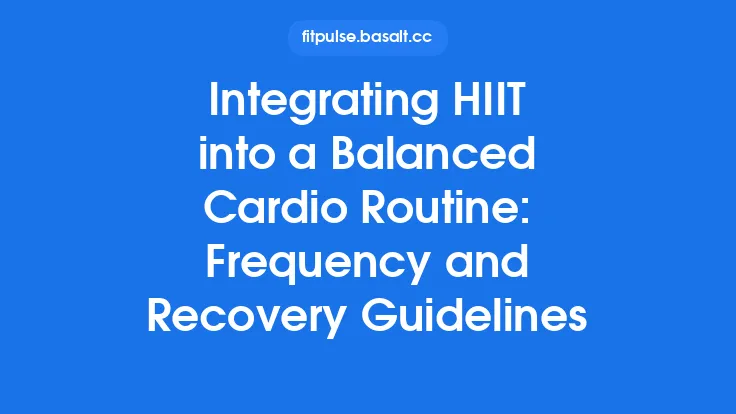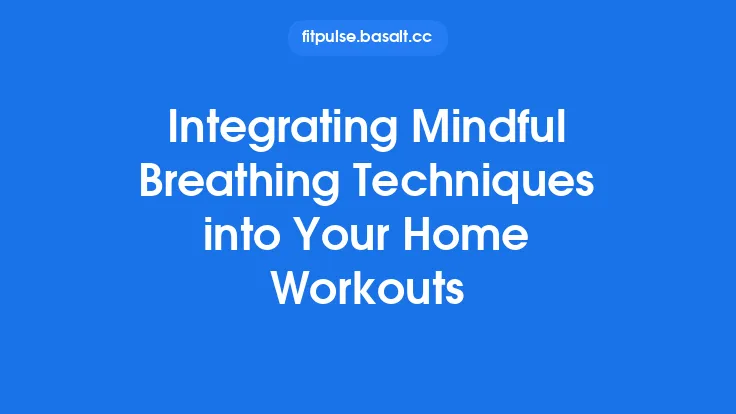Aqua fitness offers a unique blend of resistance, buoyancy, and cardiovascular challenge that can complement traditional land‑based cross‑training for swimmers, triathletes, and anyone looking to boost overall athletic performance. By moving in water, you engage muscles differently, reduce joint stress, and tap into physiological responses that are difficult to replicate on dry land. This article explores the science behind these benefits, outlines how to structure an effective water‑based program, and provides sample workouts that can be tailored to a variety of training goals.
Why Incorporate Aqua Fitness into Your Cross‑Training Routine
1. Complementary stimulus – While traditional strength and conditioning work primarily against gravity, water provides multidirectional resistance that forces muscles to stabilize and contract throughout a full range of motion. This creates a balanced development of both prime movers and stabilizers, which can translate to improved propulsion and body control in the pool.
2. Low‑impact environment – The buoyant force of water supports up to 90 % of body weight, dramatically decreasing compressive forces on the spine, hips, knees, and ankles. Athletes recovering from overuse injuries or those prone to impact‑related soreness can maintain training volume without aggravating tissue stress.
3. Enhanced cardiovascular load – Water’s density (approximately 800 times that of air) means that even modest movements generate a substantial metabolic demand. When combined with breath‑control drills, aqua sessions can elevate heart rate to 70‑85 % of maximal oxygen uptake (VO₂max), providing a potent aerobic stimulus.
4. Core activation and proprioception – The constant need to maintain balance in an unstable medium engages deep core musculature (transversus abdominis, multifidus) and improves kinesthetic awareness. These adaptations are especially valuable for swimmers who rely on a streamlined, stable torso to minimize drag.
Physiological Benefits of Water‑Based Training
| Benefit | Mechanism | Practical Implication |
|---|---|---|
| Increased muscular endurance | Continuous resistance from water viscosity forces repeated, submaximal contractions. | Longer sets with shorter rest periods become more tolerable, enhancing lactate threshold. |
| Improved VO₂max | Hydrostatic pressure and the need for controlled breathing elevate cardiac output and oxygen extraction. | Faster recovery between high‑intensity intervals on land. |
| Enhanced venous return | Hydrostatic pressure pushes blood toward the thoracic cavity, augmenting stroke volume. | Reduced heart rate at a given workload, allowing higher training intensities with lower perceived effort. |
| Greater flexibility | Warm water (27‑30 °C) raises muscle temperature, increasing extensibility without the risk of overstretching. | Improved range of motion for shoulder abduction and hip flexion, crucial for efficient swim strokes. |
| Thermoregulation benefits | Water conducts heat away from the body, preventing overheating during intense sessions. | Ability to sustain higher intensities for longer periods, especially in hot climates. |
Injury Prevention and Rehabilitation Advantages
- Joint protection: The reduced load on articular surfaces minimizes the risk of cartilage wear and osteoarthritis progression.
- Controlled loading: Resistance can be modulated simply by adjusting speed, surface area (e.g., using paddles or resistance bands), or depth, allowing progressive overload without sudden spikes.
- Targeted muscle activation: Water’s omnidirectional drag encourages activation of often‑neglected stabilizers such as the rotator cuff, scapular retractors, and hip abductors.
- Accelerated tissue healing: Hydrostatic pressure improves lymphatic drainage, reducing edema and promoting nutrient delivery to damaged tissues.
Mental and Recovery Benefits
- Stress reduction: The rhythmic nature of water movement, combined with the soothing sound of splashing, triggers parasympathetic activation, lowering cortisol levels.
- Focused breathing: Many aqua drills incorporate breath‑holding or controlled exhalation, which mirrors the respiratory patterns used in swimming and can improve breath control under fatigue.
- Active recovery: Low‑intensity water jogging or paddle work promotes blood flow without imposing metabolic strain, facilitating the removal of metabolic by‑products such as lactate.
Designing an Effective Aqua Fitness Program
1. Determine training objectives
- Endurance: Longer continuous sets (15‑30 min) at moderate intensity.
- Power: Short, explosive movements with high resistance (e.g., water sprints, plyometric jumps).
- Mobility: Dynamic stretches and flow sequences focusing on shoulder and hip range.
2. Frequency and periodization
- General population / recreational swimmers: 2–3 sessions per week, alternating between endurance and power focus.
- Competitive athletes: 1–2 dedicated aqua sessions per week, integrated into a macro‑cycle that balances pool volume and land strength work.
3. Session structure
- Warm‑up (5–10 min): Light water jogging or easy breaststroke‑style kicks to raise core temperature.
- Main set (20–40 min): Structured according to the chosen focus (see sample workouts).
- Cool‑down (5–10 min): Gentle floating, stretching, and deep breathing to promote recovery.
4. Equipment considerations
- Resistance tools: Aqua dumbbells, paddles, resistance bands, or weighted belts.
- Buoyancy aids: Float belts or kickboards for specific drills.
- Timing devices: Waterproof interval timers or smart watches with water‑resistant functions.
Sample Aqua Fitness Workouts for Different Goals
1. Aerobic Endurance Circuit (30 min)
| Set | Exercise | Duration | Intensity | Rest |
|---|---|---|---|---|
| A | Water jog (chest‑deep) | 5 min | 60‑70 % HRmax | — |
| B | Alternating flutter kicks (hold a kickboard) | 2 min | Moderate | 30 s |
| C | Horizontal pull with aqua dumbbells (wide grip) | 1 min | Moderate‑high | 30 s |
| D | Side‑to‑side shuffles (waist‑deep) | 2 min | Moderate | 30 s |
| E | High‑knee water march (chest‑deep) | 1 min | Moderate‑high | 30 s |
| Repeat | A‑E | — | — | — |
| Rounds | 4 | — | — | — |
Key points: Keep a steady breathing pattern (2:2 inhale‑exhale) and focus on smooth, continuous movement. The circuit maintains an elevated heart rate while providing varied muscular stimulus.
2. Power & Explosiveness Session (25 min)
| Set | Exercise | Reps | Load | Rest |
|---|---|---|---|---|
| 1 | Water squat jumps (deep water, using a buoyancy belt) | 8‑10 | Body‑weight + 2 kg belt | 45 s |
| 2 | Plyometric push‑offs from pool edge (hands on wall, explode forward) | 6‑8 | Body‑weight | 45 s |
| 3 | Resistance band lateral walks (ankle‑level band) | 12 each side | Light‑medium band | 30 s |
| 4 | Fast‑tempo flutter kicks (hold a small foam board) | 30 s | Body‑weight | 30 s |
| Repeat | 1‑4 | — | — | — |
| Rounds | 5 | — | — | — |
Key points: Emphasize maximal effort during the concentric phase (jump, push‑off) and controlled deceleration on the return. The water’s drag prolongs the eccentric load, enhancing muscle‑tendon stiffness and power output.
3. Mobility & Core Flow (20 min)
| Segment | Exercise | Duration | Focus |
|---|---|---|---|
| Warm‑up | Arm circles with water resistance (large circles) | 2 min | Shoulder capsule |
| Flow 1 | “Water yoga” sequence – cat‑cow, downward‑dog, and cobra (performed in shallow water) | 5 min | Spinal mobility |
| Core 1 | Flutter kick plank (hands on pool edge, legs extended) | 30 s | Core stability |
| Flow 2 | Hip circles with a resistance band around thighs | 3 min | Hip external rotation |
| Core 2 | Russian twists holding a light aqua dumbbell (seated, feet on pool floor) | 1 min | Oblique strength |
| Cool‑down | Gentle floating with deep diaphragmatic breathing | 4 min | Relaxation |
Key points: Maintain a slow, controlled tempo to maximize stretch and proprioceptive feedback. Use the water’s buoyancy to reduce spinal compression while still challenging the core.
Integrating Aqua Sessions with Land‑Based Training
| Day | Land Session | Aqua Session | Rationale |
|---|---|---|---|
| Monday | Upper‑body strength (bench, rows) | — | Primary load day |
| Tuesday | Lower‑body strength (squat, deadlift) | Aqua power circuit | Active recovery, enhances joint lubrication |
| Wednesday | Rest or light mobility | Aqua mobility flow | Improves flexibility without fatigue |
| Thursday | Interval swim set (VO₂max focus) | — | Specificity |
| Friday | Plyometric box jumps, core circuit | Aqua endurance circuit | Balances high‑intensity land work with aerobic water work |
| Saturday | Long‑distance swim or race prep | — | Primary swim volume |
| Sunday | Rest | Optional gentle water jog | Recovery |
Guidelines for seamless integration
- Timing: Schedule aqua workouts at least 4–6 hours apart from heavy land sessions to avoid cumulative fatigue.
- Intensity matching: Use the water session to complement, not duplicate, the stimulus of the land day. For example, pair a heavy leg day with a low‑impact aqua core and mobility routine.
- Monitoring: Track perceived exertion (RPE) and heart rate to ensure the combined weekly load stays within the athlete’s capacity (generally 10–12 RPE on a 1‑10 scale across the week).
Practical Tips for Getting Started
- Start with the basics: Begin with 2‑3 minute intervals of water jogging, gradually increasing duration as comfort improves.
- Focus on technique: Even though the goal isn’t stroke refinement, maintaining a neutral spine and proper limb alignment maximizes the training effect and reduces injury risk.
- Use a waterproof heart‑rate monitor: Objective data helps fine‑tune intensity zones and track progress over time.
- Stay hydrated: The cooling effect of water can mask sweat loss; drink water before, during, and after the session.
- Choose the right depth: Chest‑deep water offers optimal resistance for most exercises; deeper water is better for plyometrics, while shallow water is ideal for balance work.
- Progress gradually: Increase either the volume (time or sets) or the resistance (adding bands or weighted belts) by no more than 10 % per week.
Closing Thoughts
Aqua fitness is more than a novelty; it is a scientifically grounded modality that delivers cardiovascular, muscular, and neuromuscular benefits uniquely suited to complement traditional cross‑training. By leveraging water’s natural resistance, buoyancy, and hydrostatic pressure, athletes can enhance endurance, power, flexibility, and recovery while minimizing joint stress. Thoughtful program design—aligned with specific training goals, balanced with land‑based work, and executed with proper technique—ensures that the integration of aqua fitness becomes a sustainable, performance‑boosting component of any sport‑specific training regimen.





